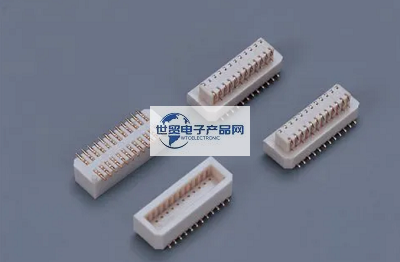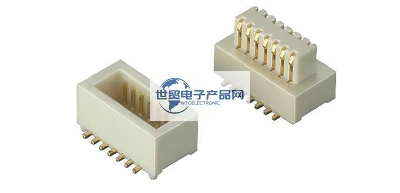Categorization:Product Information
1、 What is a board-to-board connector? The basic concept of board-to-board connector is to connect different circuit boards together. It is the connector product with the strongest transmission capacity among all connector product types at present. It is mainly used in power system, communication network, financial manufacturing, elevator, industrial automation, medical equipment, office equipment, household appliances, military manufacturing and other industries. At present, the main spacings of board-to-board connectors are 0.40 mm, 0.50 mm, 0.60 mm, 0.80 mm, 1.00 mm, 1.25 mm, 1.50 mm, 2.00 mm, 2.50 mm, 2.54 mm and 3.96 mm. 2、 Board-to-Board Connectors Classification and Characteristics Board-to-Board Connectors are divided into different types according to the different connection modes between circuit boards. Each type has its own characteristics. Here are the contents of this aspect for you one by one: First, pin and busbar/contact pin. Pin and busbar, also known as busbar, are the cheapest and most common connection modes. Application scenarios: low-end, large-size smart devices, development boards, debugging boards, etc. Advantages: cheap, convenient, hard connection is very stable, strong overcurrent capacity, easy to wire and test. Disadvantages: large size, difficult to bend, large spacing, difficult to make hundreds of pin connections (too big). Second, some high-end board-to-board row inserts are denser than row pins, which are used a lot in compact products. Application scenario: Conventional intelligent hardware products are basically in use and are widely used. Advantages: a large number of pins, small size, 1 cm in length can do 40 feet (the same size of the row plug can only do less than 20). Disadvantages: expensive, can not often plug, structural design needs to be fixed. Third, the thickened board-to-board connector is board-to-board and board-to-line, which can be disassembled, combined, and inserted on the pin. Use scenarios: development board, test board, large and fixed equipment (such as computer chassis wiring) Advantages: cheap, common, used with pins, very easy to connect and measure Disadvantages: large size, not easy to fix, not suitable for mass production scenarios. Fourth, FPC connector plug/ZIF connector Many intelligent hardware devices need to pull the signal out of the motherboard. FPC can be bent, small in size and changeable in shape, which is the best choice. Use scenarios: connection between the main board and the sub-board, connection between the main board and the peripheral, curved lines, and compact product space. Pros: Compact and cheap. What are the 3、 board-to-board connector manufacturers? At present, Tyco Electronics, Molex, Joint Tech, Amphenol, FCI and JAE are the top manufacturers of board-to-board connectors in the world.
---------------------------------------------------------------------------------------------------
How to select 4、 board-to-board connectors? It is very important for users to choose board-to-board connector products correctly. So, how to choose board-to-board connectors and what are the selection criteria? In recent years, board-to-board connectors are becoming smaller. The most common board-to-board connector pitch for handheld consumer electronics devices is 0.40 mm; While the 1.00mm stack height is a small connector, recently major OEMs are using connectors as low as 0.70mm and sometimes even lower. Older miniature connectors that were more than 4.00 mm wide a few years ago have been replaced with connectors in the 3.40 mm width range, and the current "narrow body" board-to-board concept is typically in the 2.40 to 2.60 mm range. Is it true that smaller is better for board-to-board products? There are a few things to consider when purchasing board-to-board connectors beyond the basic issues of circuit size, stack height, and width: Is it true that smaller is better? If you are willing to accept a smaller vacuum port pickup area, that may be true. Before choosing a subminiature connector, you must check that it has all the other features you need and test it carefully to make sure it is robust enough. However, it appears that a receptacle with a top-mounted connector would be desirable, as this setup would allow for tracking to be run under the receptacle, and would likely facilitate the use of conformal paint. Some of the disadvantages of top-mounted receptacles are that the width of the vacuum pickup area tends to be narrow, there is no plastic housing material above the receptacle terminals to prevent lifting in a rough disconnect action, and the more uneven top surface of the receptacle may cause problems for the operator in making connections. These new connectors with more breaking force sound great! Yes, but you may need to tolerate extra connector length in order to achieve the locking required for these connectors; more force to disconnect usually means more force to engage, which may also be a problem for larger circuit sizes. 5、 Board-to-Board Connector Test and Inspection Method I. Board-to-Board Connector Test and Inspection: 1) Observe that the voltage applied on the board-to-board connector does not exceed 50% of its rated voltage. 2) Installation dimension of the board-to-board connector For the plug-in header, the length of the soldering pin on the soldering PCB shall be greater than 0.5mm when the PCB is exposed. 3) For board-to-board connectors with high precision, if PCB space permits, try to select the model with positioning point to facilitate the operation when manual welding is required. 4) Check for fool-proof design 5) Check for lead in the material used for board-to-board connectors. 6) The board-to-board connector with small volume has small contact pressure. It is recommended to use gold-plated or silver-plated connectors when using low current and voltage to avoid film resistance affecting the signal. 7) Observe whether the height of the board-to-board connector after mating meets the soldering height of the components around the PCB. The fitting height must be greater than the welding height of the components around the PCB, and ensure that there is a certain margin to ensure that there is no interference. Special attention should be paid to the possible height error of the components after PCB welding. 6、 Board-to-Board Connection Problems and Common Troubleshooting Correct connection of board-to-board connector products can improve the service life of products and ensure the good operation of mechanical equipment. If the board-to-board product fails and is not handled in time, it will bring immeasurable economic losses. The following is a brief introduction to the connection and troubleshooting of the board-to-board connector circuit. 1) About the connection problem of the board-to-board connector The board-to-board plug and socket are used to electrically connect two separated circuit boards. It includes a first connector connected with the circuit board and an adapter connector used to connect the first connector in series. The first connector has a first terminal connected with the circuit board and a body containing the first terminal. The adapter connector is provided with a second terminal and a body for accommodating the second terminal, two extended tail ends of the second wiring terminal can be respectively inserted and matched with the first wiring terminal so as to achieve the electric conduction connection with the first connectors respectively arranged on the two circuit boards, And the proper extension length of the body and the second terminal can be selected according to the distance setting standard of the circuit board. 2) Troubleshooting of board-to-board connector Once the product fails, it can be judged that the reason is that the wire is broken in use, the product is loose, etc. The frequency of the wire breaking in the middle is not much, mostly at the connector, so the focus of the inspection should be on the sensor and the connection of the wire, to see if they have problems such as loosening and poor contact. Generally, the open circuit fault caused by poor contact is mostly due to the rust at the end of the product, and the external dirt enters the terminal or connecting socket, which leads to the reduction of contact pressure. To deal with this kind of fault, it is necessary to remove the connector, then plug it in again, change its connection condition, and make it return to normal contact.

---------------------------------------------------------------------------------------------------
2、 on the World Trade Electronic Products Network Platform and Sales Product Profile: World Trade Electronic Products Network-professional agent/production/sales of various { connector | harness | cable products }; If you have relevant [connector | harness | cable products] procurement/purchase needs or want to buy/know what connector | harness | cable products solutions we can provide, please contact our business personnel below; if you have relevant [connector | harness | cable products] sales/resources and promotion needs, please click "Business Cooperation ←" to negotiate with the specialist!